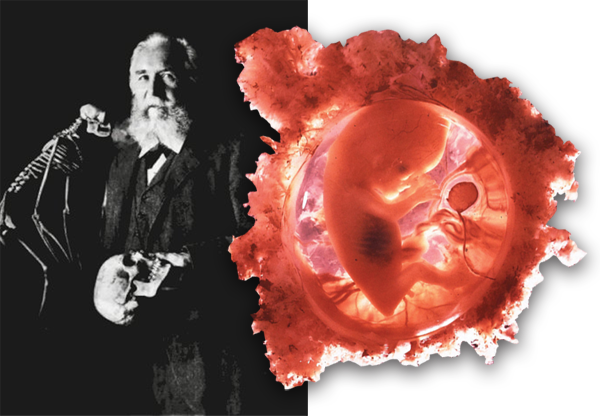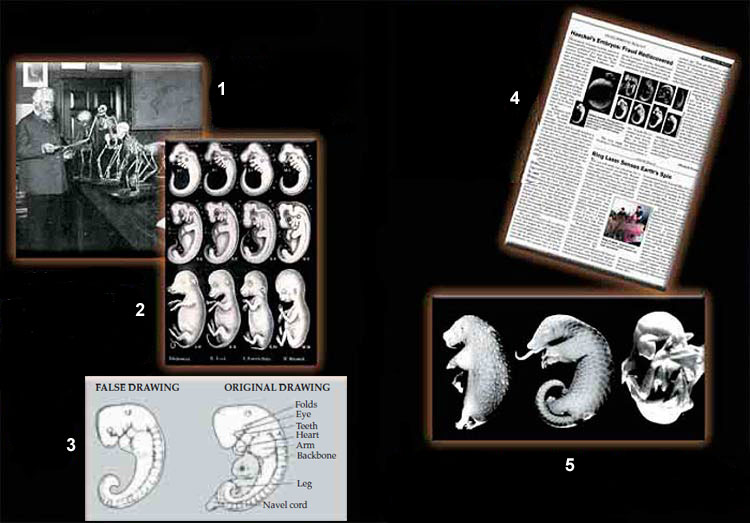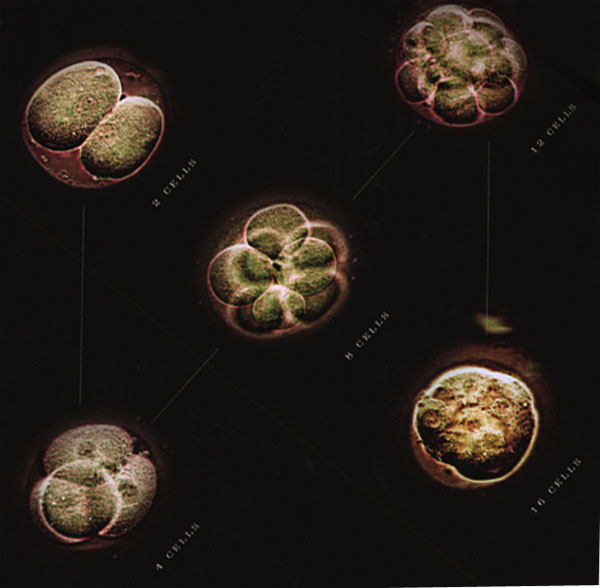In the NAS's booklet, Ernst Haeckel's "biogenetic law," an error which has been widely acknowledged to be invalid and based on a wide-scale deception, is portrayed as evidence for evolution (Science and Creationism, p. 17). In the chapter concerned, the NAS suggests that embryology represents proof that living things descended from a common ancestor and that the early stages of development of living things resemble one another. This is a claim whose validity is rejected both by the scientific community and the NAS, and even by Bruce Roberts, one of the authors of the booklet in question. In an interview, Bruce Roberts stated that Haeckel's counterfeit embryo drawings (which we shall be examining in the pages that follow) would be removed from the subsequent edition of the book Molecular Biology of the Cell, which he co-authored.1

Ernst Haeckel
The reason why the NAS still seeks to portray claims known by the scientific community to be invalid as proof of evolution is another matter requiring investigation. This chapter will explain why, contrary to what the NAS would have one believe, embryology does not represent evidence for evolution.
Although not referred to by name in the NAS booklet, Ernst Haeckel led the way in portraying embryology as proof of evolution. Haeckel invented the terms "ontogeny" and "phylogeny." Ontogeny referred to the embryonic development of an individual and phylogeny to the evolutionary history of a species. Haeckel claimed that as they developed embryos passed through the adult forms of their ancestors and "recapitulated" their evolutionary history. In other words, he proposed that as already evolved features emerged at the end of development, ancestral features could be observed in the early stages of that development. Haeckel called this so-called theory of "recapitulation" the "biogenetic law," and summed it up in the famous phrase "ontogeny recapitulates phylogeny." In his The Descent of Man, Darwin portrayed Haeckel's drawings as important evidence in support of his own theory.
Haeckel reached this conclusion not as the result of observation, but by taking the theory of evolution as his starting point. In 1909, the British zoologist Adam Sedgwick said this of Haeckel's theory:
The recapitulation theory originated as a deduction from the evolution theory and as a deduction it still remains.2
The invalidity of the theory of recapitulation was soon realized. At the beginning of the twentieth century many scientists had seen that it was incorrect.
Stephen Jay Gould wrote:
Haeckel's program of using the biogenetic law to search for entire ancestors in the embryonic stages of modern forms was pursued with much hope and fanfare, but led to few positive results and endless wranglings about untestable phylogenetic scenarios – all because the phylogenetic law is basically false. By the closing years of the nineteenth century, Haeckel's program had become a source of much ridicule…3
In an article published in American Scientist in 1988, Professor K.S. Thomson says:
Surely the biogenetic law is as dead as a doornail. It was finally exorcised from biology text books in the fifties. As a topic of serious theoretical inquiry it was extinct in the twenties.4
Molecular biologist C. McGowan's admission was particularly frank:
Like so many ideas, [recapitulation] seemed like a good one at the time, but as the creationists like to point out to us, the idea has long since been rejected.5
Ernst Mayr also admitted the truth of this in the words, "The theory is now known to be invalid ..."6
The theory of recapitulation was not rejected by scientists because it began to conflict with new discoveries; rather, it was known right from the start that the theory conflicted with the evidence. The historian of science Nicholas Rasmussen has this to say on this subject:
All the important evidence called upon in the rejection of the biogenetic law was there from the first days of the law's acceptance.7
The most important aspect of the matter is that the "biogenetic law" was actually based on a scientific fraud. In order to prove his theory, Haeckel drew distorted pictures of the embryos of different living things. These embryos were depicted as being very similar, whereas in truth they were very different.
There were various aspects to the fraudulent nature of Haeckel's drawings:
1. Haeckel selected only those embryos that he regarded as fitting his theory. Despite there being seven classes of vertebrate (jawless fish, cartilaginous fish, bony fish, amphibians, reptiles, birds and mammals), he removed the first two classes and only included drawings of the last five. Moreover, half of the embryos he selected belonged to mammals, and all belonged to the same subclass (placentals); he did not include any examples from the other two subclasses of mammals (monotremes and marsupials). As a result, Haeckel selected the specimens for his drawings in a biased manner and did not behave scientifically.
2. Despite Haeckel's biased selection of embryos, even the examples he picked did not fit his claims. He therefore resorted to counterfeiting. In 1995, the British embryologist Michael Richardson produced a detailed study revealing that Haeckel's drawings were not correct and that they were incompatible with other data available. Richardson arrived at the following conclusion: "These famous images are inaccurate and give a misleading view of embryonic development."8 In 1997, Richardson and an international team of experts compared Haeckel's embryos with real specimens from the seven classes of vertebrates. It was thus demonstrated that Haeckel's drawings were full of major distortions.
3. In addition, Richardson and his team found major variation among the embryonic morphologies (shapes) of amphibians. Yet, Haeckel selected only the salamander from amongst the amphibians so that it would fit his theory. Had he selected the frog, for instance, the great differences in embryonic stages would have been apparent, and his theory would have been falsified.

1) Ernst Haeckel deceived the scientific world for a century with his counterfeit embryo drawings.
2-3) Haeckels drawings can be seen on the right. Below is a detail from these drawings: A false illustration designed to prove that there were similarities between human and fish embryos. Compared to a real human embryo, it can be seen that a large number of the organs have been deliberately removed. (Francis Hitching, The Neck of the Giraffe: Where Darwin Went Wrong, p. 205)
4) In its September 5, 1997, issue, the famous journal Science published an article revealing that Haeckel's embryo drawings were frauds. The article described how embryos are in fact very different from one another.
5) Observations in recent years have revealed that, contrary to what Haeckel claimed, the embryos of different living things do not resemble one another. The differences between the mammal, reptile, and bat embryos seen above are a clear example of this.
4. Richardson and his team also observed extraordinary variations in the dimensions of vertebrate embryos, of between 1 and 10 mm. Haeckel, however, had drawn them all with the same dimensions.
5. Finally, Richardson and his colleagues observed tremendous variation in somites—blocks of muscle tissue that form along each side of the embryo's developing backbone. Although Haeckel's drawings had portrayed all the classes as having more or less the same number of somites, in reality the number varied between 11 and 60 in actual embryos. Richardson and his team arrived at the following conclusion:
"Our survey seriously undermines the credibility of Haeckel's drawings."9
When Haeckel's embryos were compared to actual embryos it was openly apparent that Haeckel had deliberately distorted his drawings to make them fit his theory. In the March 2000 issue of Natural History, Stephen Jay Gould wrote that Haeckel "exaggerated the similarities [between embryos of different species] by idealizations and omissions," and that, furthermore, Haeckel's drawings were characterized by "inaccuracies and outright falsification."
In an interview with the journal Science following the publication of his research, Richardson characterized Haeckel's drawings in these terms: "It looks like it's turning out to be one of the most famous fakes in biology." In the September 5, 1997, issue of Science, the following words appear in an article called "Haeckel's Embryos: Fraud Rediscovered":
The impression they [Haeckel's drawings] give, that the embryos are exactly alike, is wrong, says Michael Richardson, an embryologist at St. George's Hospital Medical School in London… So he and his colleagues did their own comparative study, reexamining and photographing embryos roughly matched by species and age with those Haeckel drew. Lo and behold, the embryos "often looked surprisingly different," Richardson reports in the August issue of Anatomy and Embryology.10
The article in Science stated that Haeckel had deliberately removed organs from his drawings in order to portray the embryos as similar, or else had added non-existent organs. The article continues:
Not only did Haeckel add or omit features, Richardson and his colleagues report, but he also fudged the scale to exaggerate similarities among species, even when there were 10-fold differences in size. Haeckel further blurred differences by neglecting to name the species in most cases, as if one representative was accurate for an entire group of animals. In reality, Richardson and his colleagues note, even closely related embryos such as those of fish vary quite a bit in their appearance and developmental pathway. "It (Haeckel's drawings) looks like it's turning out to be one of the most famous fakes in biology," Richardson concludes.11
Haeckel suggested that embryos resembled each other more closely in the early stages of development. The fact is, however, that his drawings do not include the early stages, but rather begin at the middle stages of development. There are considerable differences between them in the early stages.
Let us examine the first stages of the vertebrate embryos and the forms they take in order to see this deception. When an animal egg is fertilized, it first undergoes a process known as "cell division." At the end of division, the cells begin to move and organize themselves in a second process known as "gastrulation," which is more important than division with regard to the general emergence of body plan, tissue type, and organ systems.

Cell Division
After division and gastrulation, a vertebrate embryo enters the stage referred to by Haeckel as the "first phase." If, as Haeckel claimed, vertebrates possessed the greatest similarity during the earliest phase of their development, then different classes would resemble each other most closely during division and gastrulation. However, research into the five vertebrate classes given as examples by Haeckel (bony fish, amphibians, reptiles, birds, and mammals) shows that this is not the case.
The differences between the five classes are clear, even in the fertilized egg. Zebrafish and frog eggs are about 1 mm in diameter; the turtle and chick begin as discs 3 or 4 mm in diameter above the yolk; while the human egg is only one-tenth of a millimeter in diameter. The earliest cell divisions in zebrafish, turtle, and chick embryos resemble each other somewhat. However, in many frogs the embryos penetrate the yolk. Mammals are very different. Cell movements at the end of division and during gastrulation are very different in the five different classes. In the zebrafish, cells move slowly outside the yolk, which brings about the development of the embryo. In frogs, cells move as interconnected thin layers, through a pore into the inner cavity. In turtles, chicks, and humans they flow along a channel into the internal cavity of the embryonic disc. If the theory regarding the early development of vertebrates were correct, we would expect these five classes to resemble each other most closely as fertilized eggs, to show more differences during division, and still more during gastrulation. Yet, that is not what we observe. The eggs of the five classes begin life in very different ways.
The really interesting thing is that a theory which the world of science has regarded as invalid for decades should be put forward by the NAS as evidence of evolution. The NAS probably refrains from mentioning Haeckel's name in the chapter in question, since that name is redolent of fraud; and yet it goes along with that same fraud by describing Haeckel's false theory as if it were scientific fact.
1. James Glanz, "Biology Text Illustrations More Fiction Than Fact," New York Times, April 8, 2001. 
2. Adam Sedgwick, The Influence of Darwin on the Study of Animal Embryology, pp. 171-184 in A.C. Seward (editor) Darwin and Modern Science, Cambridge: Cambridge University Press, 1909, pp. 174-176.
3. S.J. Gould, Heterochrony, in Keller and Lloyd (editors), 1992, p. 161.
4. Keith Stewart Thomson, "Ontogeny and Phylogeny Recapitulated," American Scientist, vol. 76, May-June 1988, p. 273.
6. Ernst Mayr, The Growth of Biological Thought : Diversity, Evolution and Inheritance, The Belknap Press of Harvard University Press, 1982, p. 215. (emphasis added)
7. Nicholas Rasmussen, "The Decline of Recapitulationism in Early Twentieth-Century Biology:Disciplinary Conflict and Consensus on the Battleground of Theory", Journal of the History of Biology, 24 (1991), pp. 51-89.
8. Michael K. Richardson, "Heterochrony and the Phylotypic Period," Developmental Biology, 172 (1995), pp. 412-421.
9. M. K. Richardson, et al., "There is no highly conserved embryonic stage in the vertebrates: implications for current theories of evolution and development", Anatomy & Embryology, 196 (1997), pp. 91-106; See also, Michael K. Richardson, Steven P. Allen, Glenda M. Wright, Albert Raynaud, and James Hanken, "Somite number and vertebrate evolution," Development, 125 (1998). 
10. Elizabeth Pennisi, "Haeckel's Embryos: Fraud Rediscovered," Science, September 5, 1997. (emphasis added)
11. Elizabeth Pennisi, "Haeckel's Embryos: Fraud Rediscovered," Science, September 5, 1997. (emphasis added)